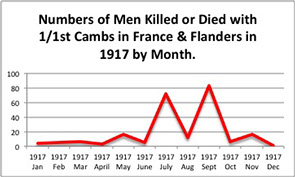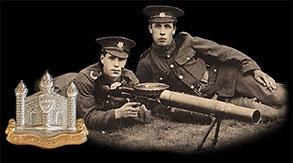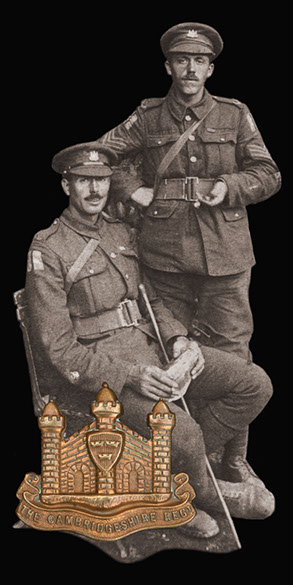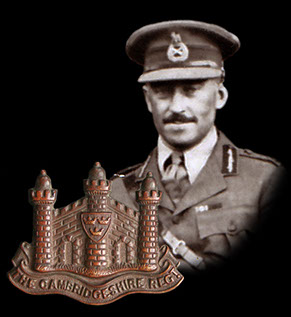
Who Were
The Cambs
The Cambs
at War
1/1st Btn 1914-1919
1914 - 1/1st Overview
1915 - 1/1st Overview
1915 - St Eloi
1915 - Fosse Wood
1916 - 1/1st Overview
1916 - The Schwaben
1916 - St Pierre Divion
1917 - 1/1st Overview
1917 - St Julien
Insignia, Medals & Books
Remembering The Cambs
Biographies
About Us &
This Site

Menu of 1917 Related Pages

A Cambs 2nd Lt and Herts Regt men.

Two Cambs Lewis machine gunners.

CSM Burbridge MC & Sgt Latham DCM.

Ted Riddell just after leaving the Cambs.
1917
January
The New Year found the Cambs in the trenches of the Ypres Salient, on the 1st the Germans launched a small surprise raid on one of the Cambs positions. It was successfully spotted and quickly dealt with. Much of the month was spent either in various sectors of the front line or in the Canal Bank dugouts. The cold and damp weather was a constant problem and most days men were kept busy on various working parties. On the 25th January the Cambs were relieved and pulled back from the line to Brandhoek for a rest.
February
After just over a week at the Brandhoek camp the Cambs returned to the Canal Bank on the 4th February and were back in the front line by the 11th. The frozen ground made conditions tough and sporadic enemy shelling caused several casualties, further details about the Battalion at this time can be found here. The Battalion was back out of the line on the 16th and proceeded to Hipshoek Camp. While they were still at this camp on the 26th Lt. Col Riddell returned and resumed command.
March
The Cambs returned to their old 1915 battlegrounds near Hooge. On the 3rd March they went into the front line at Sanctuary Wood. The rest of the month was spent in the trenches around Hooge or back at Winnipeg Camp.
April
The time around Hooge came to an end on the 2nd April and by the 9th the Battalion was at rest in billets at Peselhoek. While at the billets the Cambs men were tasked with helping build a nearby railway and also laying communication cables. On the 28th the Cambs returned to the Canal Bank dugouts and then were sent back up to the front line around Hill Top Farm. A more detailed account of the period of April to May can be found here.
May
Activity in the sector of front line around Hill Top Farm had increased since the Cambs were there in February. Night time raids and scouting missions became a regular occurrence. On the 14th the Cambs carried out a successful raid on the German trenches and several prisoners were brought back. The Battalion left the line on the 29th and moved to Wormhoudt.
June
After a stay at Wormhoudt the Cambs moved to billets at Lumbres and spent time training for trench attacks and open country fighting. While away from the front line the Battalion also had numerous working parties attached to the Royal Engineer Tunnelling Companies. All the men were well aware of the build up of troops and activity in the area and would have known an offensive was looming. By the end of the month the Cambs were back in the trenches around the Hill Top sector.
July
The continuing wet weather and shell fire made life in the front line trenches even more difficult and working parties constantly worked to try to drain and hold back the trench sides. The Battalion remained in the Hill Top and Canal Bank areas until the 15th when they were relieved and moved to the camp at Brandhoek and then on to Houlle.
At Houlle the Army had gone to great lengths to lay out replicas of the areas that were to be attacked. The whole of the 39th Division spent a week training on the ground for its part in the coming offensive. On the 22nd the Cambs moved to a camp at St Jan-ter-Biezen for further training and then back to the Brandhoek camp on the 29th. The date for the start of the offensive had been set as the 31st July and at 10pm on the 30th the Cambs moved to the familiar ground around the Canal Bank.
The ultimate objective for the 118th Brigade, with the Cambs initially in reserve, was named the Green Line. This ran along a hill crest on the far side of the village of St Julien. To reach this objective the German line and the village itself would need to be captured and cleared. The great Battle of Passchendaele began with a fierce artillery bombardment and initially the advance went well. At 5.30am the Cambs moved out following the assaulting battalions.
As the Cambs reached the Black Line (the name for the second objective line) the enemy fire intensified. Confusion, thick mist, mud and a lack of artillery support was starting to have effect on the assault battalions and elsewhere in the advance things had not gone to plan. The Cambs still in the planned formations took up positions beyond the Black Line. It soon became apparent that the 55th Division off to the Cambs right flank was not there. In order to try and defend this massive gap part of C Coy was moved into a position known as Border House. This captured blockhouse had become the crucial point holding the whole 39th Divisions right flank.
The Cambs was now spread out along the line from the village of St Julien itself to Hill 19 and Border House. An increase in enemy shell fire and a fierce counter-attack pushed back the assaulting battalions and quickly the situation changed. The Cambs were now holding a new front line and were exposed. Wave after wave of enemy counter-attacks fell on the Cambs positions which clung on despite rapidly mounting losses.
As units either side of the Cambs pulled back the Battalion's position became more and more vulnerable. The 55th Division was still not in position and reinforcements were not coming up as needed. The order was finally given to pull back to the Black Line and the captured village of St Julien was lost. The Cambs suffered 65 killed and nearly 200 wounded. The defenders of Border House were all but wiped out by the time written orders to pull out reached them.
A more detailed account of the Cambridgeshires fighting on the opening day of the 3rd Battle of Ypres can be found by clicking here.
August
The shattered remains of the Battalion remained at the front until the 5th August when they were pulled back. Numerous drafts of replacements reached the Cambs from the UK in an attempt to get it back up to strength. The Cambs spent the next several weeks resting, refitting and training at various camps behind the Salient. They returned to the front line on the 19th August in the Klein Zillebecke Sector where they remained either in the front line or in reserve for the rest of the month. A more detailed account of August 1917 can be found here.
September
The Cambs were once again moved back into the line on the 2nd September this time around Hill 60. During the first week enemy artillery fire was heavy and most days men were lost to it. The next three weeks were spent either in the line or back at a camp near Dezon. Along the Salient the offensive continued and the Cambs turn to attack again was due, this time to the east of the Salient. On the evening of the 25th the Battalion moved back into the line in preparation for an attack the following morning.
The Tower Hamlets attack on the 26th September was launched at 5.50am under a heavy artillery bombardment. After hours of heavy fighting the Cambs took most of their objectives and occupied much of the German strong point known as Joist Redoubt. The attack was once again costly for the Cambs with over 60 men killed and many more wounded. A full account of the fighting at Joist Redoubt can be found here.
Lt Col Riddell was promoted and left the Cambs on the 30th September and the new CO arrived to take command. He was Maj Saint, a pre-war Cambs officer who had served with the Battalion at various stages since its arrival in France.
October
The Battalion was battered and weary after the operations in the Passchendaele offensive, in early October they were moved to a camp near Kruisstraat. Much of their time here was spent on railway construction in order to speed up the flow of supplies for the continuing offensive. They returned to the front on the 28th, initially in reserve but by the 31st they were in the font line around Tower Hamlets once again. A more detailed account of the Cambridgeshires' time from October to January 1918 can be found by clicking here.
November
For nearly all of November the Battalion remained in the Menin Road - Tower Hamlets area of the Salient, either in the line or at camp. Conditions around the Menin Road were appalling and the trenches and shell holes were mostly flooded. The great offensive was fizzling out and the Salient was quietening down however shelling continued and several enemy night raids were beaten back. The biggest of these was on the 15th and several wounded enemy were taken prisoner.
December
The Cambs were given a break from the Salient and moved out to Henneveux near Boulogne. They arrived there on the 9th and after organising billets and fresh clothing spent much of the next several weeks training. Christmas Day was spent at rest and a large turkey and goose dinner was organised for the men served by the officers. Heavy snow fall the following day led to an organised Battalion snowball fight described by one officer as "almost as hazardous as Ypres".
The Cambs left the camp on the 29th and started to make their way back to Ypres. The journey was made difficult due to the snow and the freezing conditions. After problems with the transport they spent New Years Eve at billets in Seninghem.

This site went live on the 14th February 2015 to mark 100 years since the 1/1st Cambs went off to war.
WE WILL REMEMBER THEM
Email us: cambsregt@gmail.com
Copyright 2015, 2016, 2017, 2018, 2019 by Felix Jackson. The information and images on this site should not be reproduced without prior permission.
